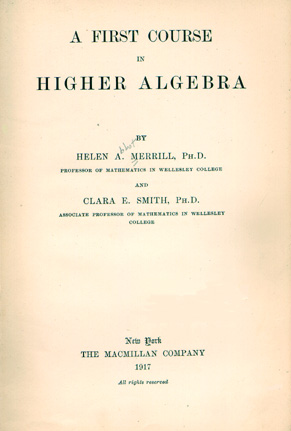Helen A. Merrill
Clara E. Smith
A First Course in Higher Algebra
The Macmillan Company, New York, 1917

Preface
This book is an outgrowth of the conviction of the authors that Higher Algebra, to be worthy of the name, must employ advanced methods, and that the method which chiefly marks advanced work in analysis is that of limits. In all but a few chapters the work is based upon limits, the proofs being made as rigorous as seems advisable for immature students, with occasional comment on points where the proof is not rigorous, or where theorems not yet proved are employed. It is our hope that there is nothing to be unlearned in later work
The ordinary Algebra course in college covers a semester's work—about forty-five class appointments. It has been found by actual use that in this time Chapters III, IV, V, VI, VII, XII can be covered, while Chapter X has been taught in connection with a course in Trigonometry. The chapters on Rational and Irrational Numbers are intended for reference rather than for detailed study, while the chapters on Permutations, Combinations and Probability, Partial Fractions, Complex Numbers, and Integration may be substituted for other chapters as subjects of study, or serve for reference in later work.
No mathematical knowledge is presupposed beyond the usual course in Elementary Algebra, except that a knowledge of the meaning of the trigonometric tangent is assumed in § 105, while in Chapter XI anything beyond the simplest treatment of the complex number necessitates the introduction of trigonometric formulas, which are first employed in § 195.
The text has as its main ends to broaden the students' thought by introducing them as early as possible to some of the most beautiful and most fruitful methods in analysis, with a few of their results; to give an acquaintance with the simplest notions of the Calculus, which are of the upmost use not only in Analytic Geometry, but also in Physics and Mechanics, and which shorten and simplify the early work in the regular Calculus course; and to open up to students some vision of the possibilities of later work along lines here treated only briefly. The students who are interested to do more than the assigned work have been kept constantly in mind, and it is hoped that there is much here to arouse curiosity, and to lead such students to find for themselves what lies just beyond. If some few are helped to a new realization of the wide range, the elegance, the simplicity, and the charm of these results of human thought and endeavor, our book will serve its purpose.
Wellesley College, May, 1917
Table of Contents
- Rational Numbers
- Permutations, Combinations, Probability
- Determinants
- variables and their Limits
- Differentiation of Algebraic Functions
- Convergence of Series
- Development of Functions in Series
- Partial Fractions
- Irrational Numbers
- Logarithms
- Complex Numbers
- Theory of Equations
- Elementary Theory of Integration
